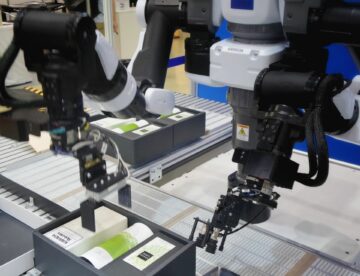Business is ever-changing and business process automation (BPA) has emerged as a powerful tool that enables companies to achieve these goals by automating repetitive, manual tasks and streamlining workflows for organizations that are constantly seeking ways to optimize their processes, enhance efficiency, and gain a competitive edge.
Artificial intelligence, machine learning, and automation have already changed the way we do business, especially in the last year. Think about it, when was the last time you did a repetitive job completely by yourself? How many times have you resorted to the help of AI tools when making a calculation related to your work?
What if all this was done automatically before you even thought of it?

What is business process automation?
Business process automation (BPA) refers to the utilization of technology to automate manual, repetitive tasks within business processes. By employing software, robotics, or other technological tools, organizations can streamline operations, reduce errors, and enhance overall productivity.
The widespread adoption of business process automation is fueled by several compelling factors:
- Cost reduction: Automating repetitive tasks minimizes the need for human labor, leading to significant cost savings
- Improved efficiency: Automation streamlines workflows, eliminating bottlenecks and reducing time spent on manual tasks
- Enhanced accuracy: Automation eliminates human error, ensuring greater accuracy and consistency in task execution
- Increased productivity: Employees are freed from mundane tasks, allowing them to focus on more strategic and value-added activities
- Improved customer service: Streamlined processes and reduced response times enhance customer satisfaction and loyalty
What is RPA and how is it related to BPA?
Robotic process automation (RPA) is a type of business process automation (BPA) that uses software robots, also known as bots, to automate repetitive tasks that are typically performed by humans. RPA bots are programmed to mimic human actions, such as clicking on buttons, typing, and copying and pasting data.
They can be used to automate a wide variety of tasks, including:
- Data entry
- Customer service
- Order processing
- Financial reporting
- IT support
RPA is a powerful tool that can help businesses to improve efficiency, accuracy, and productivity. It can also help businesses to reduce costs and improve customer satisfaction.
BPA and RPA are two different but complementary technologies. BPA is a broader term that encompasses a variety of approaches to automating business processes. RPA is a specific type of BPA that uses software robots to automate tasks.
RPA can be used as a standalone tool to automate tasks, but it is often used in conjunction with other BPA tools, such as business process management (BPM) software and workflow automation tools. This can help to create a more comprehensive and integrated approach to automation.

How does business process automation work?
Business process automation (BPA) works by using software or other tools to automate tasks that are typically done by humans. This can be done by creating a workflow, using triggers, or using data.
A workflow is a set of steps that are followed to complete a task. Business process automation software can be used to create workflows that automate these steps. For example, a workflow could be created to automate the process of onboarding a new employee. This workflow could include steps such as sending out a welcome email, configuring security credentials, and setting up financial details in the compensation system.
Triggers are events that cause a workflow to start. For example, a customer placing an order could be a trigger that starts a workflow to process the order. This workflow could include steps such as verifying the customer’s credit card information, checking inventory levels, and shipping the order.
Data can be used to make decisions about how to automate a task. For example, a business process automation system could use data to identify customer orders that are in danger of being late and then automatically escalate them to a supervisor. This could help to ensure that customer orders are delivered on time.
What are the best process automation softwares of 2023?
So you don’t have the slightest coding or planning knowledge and how will you implement business process automation? Of course, there are many commercial tools available to help you and your business.
Here are some of the top process automation software tools available in 2023:
UiPath
UiPath is a leading RPA platform that offers a wide range of features, including drag-and-drop automation, AI-powered capabilities, and cloud-based deployment. UiPath is known for its ease of use and flexibility, making it a popular choice for businesses of all sizes.
Automation Anywhere
Automation Anywhere is another popular RPA platform that is known for its ease of use and strong customer support. Automation Anywhere offers a user-friendly interface and a variety of pre-built templates, making it easy to get started with business process automation.
The platform also offers strong customer support to help businesses of all sizes implement and manage their business process automation projects.
Blue Prism
Blue Prism is a powerful RPA platform that is well-suited for complex business process automation projects. Blue Prism offers a wide range of features, including advanced OCR and AI capabilities, making it a versatile tool for automating a variety of tasks.
The platform is also known for its scalability and security, making it a good choice for businesses with demanding business process automation needs.

Microsoft Power Automate
Microsoft Power Automate is a cloud-based workflow business process automation platform that is part of the Microsoft Power Platform suite. Power Automate is a good choice for businesses that are already using other Microsoft products, such as Office 365 and Dynamics 365.
The platform offers a variety of pre-built connectors and templates, making it easy to connect to different apps and services.
Kissflow
Kissflow is a cloud-based business process automation platform that is known for its user-friendly interface and pre-built templates. Kissflow is a good choice for businesses that need a simple and easy-to-use automation platform.
Kissflow offers a variety of pre-built templates for common business processes, such as onboarding new employees and processing orders.
Not sure which business process automation tool to use? Here is a comparison table:
| Feature | UiPath | Automation Anywhere | Blue Prism | Microsoft Power Automate | Kissflow |
| Deployment | On-premises, cloud, hybrid | On-premises, cloud | On-premises, cloud | Cloud | Cloud |
| Ease of use | Easy to use | Easy to use | More complex to use | Easy to use | Very easy to use |
| Features | Wide range of features, including AI-powered capabilities | Strong customer support, a variety of pre-built templates | Advanced OCR and AI capabilities, scalable and secure | Pre-built connectors and templates, good for businesses already using Microsoft products | User-friendly interface, pre-built templates for common business processes |
| Scalability | Highly scalable | Highly scalable | Highly scalable | Scalable | Scalable |
| Security | Strong security features | Strong security features | Strong security features | Compliant with Microsoft security standards | Compliant with SOC 2 and ISO 27001 |
| Pricing | On-demand pricing | On-demand pricing | On-demand pricing | Free plan available, paid plans start at $15 per user per month | Free plan available, paid plans start at $10 per user per month |
Technology is advancing so rapidly that technological developments in the past often had to adapt to human life and go through a process. Today, this has changed almost completely. Now we, as human beings, have to keep up with technology. Every day we meet a new software or automation system and the question “how can I benefit from it” is always in the corner of our minds.
If you don’t want to fall behind in this race of adaptation, it’s time to slowly integrate business process automation into your business.
Featured image credit: Freepik.
- SEO Powered Content & PR Distribution. Get Amplified Today.
- PlatoData.Network Vertical Generative Ai. Empower Yourself. Access Here.
- PlatoAiStream. Web3 Intelligence. Knowledge Amplified. Access Here.
- PlatoESG. Carbon, CleanTech, Energy, Environment, Solar, Waste Management. Access Here.
- PlatoHealth. Biotech and Clinical Trials Intelligence. Access Here.
- Source: https://dataconomy.com/2023/11/21/what-is-business-process-automation-and-how-it-works/
- :has
- :is
- $UP
- 1
- 14
- 15%
- 2023
- a
- About
- about IT
- accuracy
- Achieve
- actions
- adapt
- adaptation
- Adoption
- advanced
- advancing
- AI
- AI-powered
- All
- Allowing
- almost
- already
- also
- always
- an
- and
- Another
- anywhere
- approach
- approaches
- apps
- ARE
- AS
- At
- automate
- automatically
- automating
- Automation
- automation anywhere
- available
- BE
- before
- behind
- being
- beings
- benefit
- BEST
- Blue
- bots
- bottlenecks
- broader
- business
- Business Process
- Business Process Automation
- Business Process Management
- business processes
- businesses
- but
- by
- calculation
- CAN
- capabilities
- card
- Cause
- changed
- checking
- choice
- Cloud
- Coding
- commercial
- Common
- Companies
- comparison
- compelling
- Compensation
- competitive
- complementary
- complete
- completely
- complex
- comprehensive
- conjunction
- Connect
- constantly
- copying
- Corner
- Cost
- Costs
- could
- course
- create
- created
- Creating
- Credentials
- credit
- credit card
- customer
- Customer satisfaction
- Customer Support
- DANGER
- data
- day
- decisions
- delivered
- demanding
- deployment
- details
- developments
- DID
- different
- do
- does
- done
- Dont
- dynamics
- ease
- ease of use
- easy
- easy-to-use
- Edge
- efficiency
- eliminates
- eliminating
- emerged
- Employee
- employees
- employing
- employs
- enables
- encompasses
- enhance
- ensure
- ensuring
- error
- Errors
- escalate
- especially
- Even
- events
- ever-changing
- Every
- every day
- example
- factors
- Fall
- Features
- financial
- Financial details
- Flexibility
- Focus
- followed
- For
- from
- fueled
- Gain
- get
- Go
- Goals
- good
- greater
- had
- Have
- help
- here
- High
- How
- How To
- HTTPS
- human
- Humans
- i
- identify
- if
- image
- implement
- improve
- improving
- in
- include
- Including
- information
- integrate
- integrated
- Intelligence
- Interface
- into
- inventory
- ISO
- IT
- ITS
- Job
- jpg
- Keep
- knowledge
- known
- labor
- Last
- Last Year
- Late
- leading
- learning
- let
- levels
- Life
- machine
- machine learning
- make
- Making
- manage
- management
- manual
- many
- max-width
- Meet
- Microsoft
- minds
- minimizes
- more
- multiple
- Need
- needs
- New
- now
- OCR
- of
- Offers
- Office
- Office 365
- often
- on
- Onboarding
- Operations
- Optimize
- or
- order
- orders
- organizations
- Other
- our
- out
- overall
- paid
- part
- past
- per
- performed
- placing
- plan
- planning
- plans
- platform
- plato
- Plato Data Intelligence
- PlatoData
- Popular
- power
- Power Automate
- powerful
- process
- Process Automation
- Process Management
- processes
- processing
- productivity
- Products
- programmed
- projects
- question
- Race
- range
- rapidly
- reduce
- Reduced
- reducing
- refers
- related
- repetitive
- response
- response times
- robots
- rpa
- satisfaction
- Scalability
- scalable
- security
- seeking
- sending
- Services
- set
- setting
- several
- Shipping
- significant
- Simple
- sizes
- Slowly
- So
- Software
- some
- specific
- spent
- standalone
- start
- started
- starts
- Steps
- Strategic
- streamline
- streamlined
- streamlining
- strong
- such
- suite
- support
- sure
- system
- table
- Take
- Task
- tasks
- technological
- Technologies
- Technology
- templates
- term
- that
- The
- their
- Them
- then
- There.
- These
- Think
- this
- thought
- Through
- time
- times
- to
- today
- tool
- tools
- top
- trigger
- two
- type
- typically
- UiPath
- use
- used
- User
- user-friendly
- uses
- using
- variety
- verifying
- versatile
- want
- was
- Way..
- ways
- we
- welcome
- What
- What is
- Wheel
- when
- which
- wide
- Wide range
- widespread
- will
- with
- within
- Work
- workflow
- workflow automation
- workflows
- works
- year
- you
- Your
- yourself
- zephyrnet












